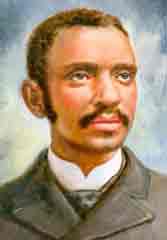We should remember groundbreaking journalist during Black History Month
By JIM BROOKS
Nelson County Gazette
Sunday, Feb. 23, 2020 — The Bardstown City Council — for the first time in recent history — passed a resolution at its meeting Feb. 11, 2020, in honor of February’s status as Black History Month.

The resolution was added late to the agenda for Tuesday’s meeting, and the effort was launched when Bardstown High School Principal Chris Pickett was asking Councilman Roland Williams if the council took any steps to recognize February as Black History Month.
Williams contacted Mayor Dick Heaton about a resolution, and that set people in motion in an effort to craft a resolution for Tuesday’s meeting.
The credit for drafting the actual Black History Month resolution goes to Assistant City Clerk Lisa Burdett, who told me she did the research for the information she used in creating the resolution in time for the council meeting, which was the council’s first meeting of the month.
The resolution — (click here to download it), gives recognition to the contributions African Americans have made to our community throughout its history. It recognizes several national African Americans, including Charles Anderson Jr., Kentucky’s first African Amerian legislator in the South since Reconstruction; Mary Ellen Britton, a physcian, educator, suffragist, journalist and civil rights activist; Willa Brown Chappel, the first African American to earn a pilot’s license; and of course, Muhammed Ali, the professional boxer who became a noted activist and philanthropist, and is arguably one of the 20th Century’s most celebrated athletes.
There are many local individuals who could be recognized for their contributions and leadership in our local black community, some of whom whose names are mostly lost to time.
This would include a member of Bardstown’s black community who was born into slavery and raised as a devout Catholic. He went on to be an activist and journalist who was the founder of the nation’s first black-owned national Catholic newspaper.

WHO WAS DANIEL RUDD? Daniel Rudd was born in Aug. 7, 1854, at the Anatok mansion here in Bardstown. Rudd grew up in Bardstown in the shadow of St. Joseph Cathedral. As a young man, he left Bardstown to pursue a career in journalism. He followed the example of Fredrick Douglas in his work to protect the civil rights of African Americans.
To that end, he believed the press played a pivotal role in advance black causes by educating and persuading Catholic business and civic leaders.
Rudd founded his first Catholic newspaper, the Ohio Tribune, later called the American Catholic Tribune, in 1885. He believed the newspaper a vital took in bringing equality and social justice to the black community.
As publisher and editor, the newspapers Rudd operated reflected his personal philosphy: “The Catholic Church alone can break the color line. Our people should help her do it.”
Later in his life, Rudd returned to Bardstown. He died here in 1933 and is buried at St. Joseph Cemetery.
It’s ironic to me that the birthplace of a Bardstown resident who became a leading figures in black history and Catholic journalism has fallen into disrepair.
You might think that the Anatok mansion — given its substantial connections to Catholicism, would be worthy of preservation. Unfortunately, that’s not the case.
Bethlehem High School, under the leadership of its principal, Tom Hamilton, and the Archdiocese of Louisville, have worked incessantly for the home’s demolition. Their efforts have continued for years. Local historic preservationists went to court to stop the demolition of this historic property.
In addition to being the birthplace of Daniel Rudd, Anatok also served as home to the Sisters of Charity of Nazareth. The sisters owned what was left of the farm, and they used Anatok as their home to serve the Bardstown Catholic community.
And we can’t overlook the SCN’s contributions to the community while they owned Anatok. The SCNs provided the land on which Flaget Memorial Hospital was built. The hospital operated for 54 years on Cathedral Manor until the new hospital opened in 2005 on KY 245.
The SCNs founded Bethlehem as an elementary school in 1819, adding the high school in 1911. In 1953, the elementary grades moved to St. Joseph and Bethlehem continued operating as a high school.
The property on which Bethlehem High School is located was an original part of the Anatok property.
The Anatok property is steeped in Catholic history and tradition. The real irony is that the same Catholic church Rudd so passionately served is the same Catholic church that today owns Anatok and has fought all attempts at its historic preservation.
During Black History Month, I think its appropriate to remember the contributions of Daniel Rudd to renew the call to preserve Anatok and its place in Kentucky Catholic history.
-30-





